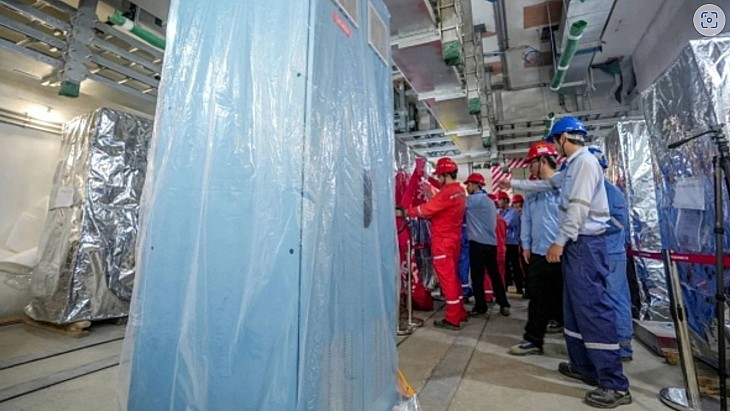Digital control system installation begins at Chinese SMR

The first cabinet of the digital control system system - the 'nerve centre' of nuclear power plant operation - was moved into place at 9.58am on 10 April, and installation and debugging work has now started, CNNC said.
The digital control system (DCS) system for the ACP100 - referred to as the Linglong One - adopts two domestically-developed platforms: the Dragon Scale platform (safety level) and Dragon Fin platform (non-safety level). The Dragon Scale platform can realise reactor safety control under various working conditions and ensure the safe operation of the nuclear power plant. Meanwhile, the Dragon Fin platform is responsible for operation and management and is an important guarantee for the efficient and economical operation of the nuclear power plant. Between them, the two platforms control hundreds of systems within the nuclear power plants, nearly 10,000 equipment operations and various operating conditions.
The first Dragon Fin platform cabinet that has now been put in place is a plant-wide non-safety control system specially developed by CNNC for large nuclear facilities, such as nuclear power plants. The company said this platform inherits and develops the nuclear power instrumentation and control experience and key technologies accumulated by CNNC over the years, integrating the latest advanced technologies such as data collection, process control, large-scale networking and information management to meet the requirements of high reliability and safety of nuclear facilities.
.jpg)
(Image: CNNC)
"The smooth introduction of the first DCS cabinet in Linglong One, the world's first land-based commercial small modular reactor, marks the transition of DCS to the on-site installation stage, laying the foundation for subsequent work such as the availability of the main control room," CNNC said.
CNNC announced in July 2019 the launch of a project to construct an ACP100 reactor at Changjiang. The site is already home to two operating CNP600 pressurised water reactors (PWRs), while the construction of the two Hualong One units began in March and December 2021. Both those units are due to enter commercial operation by the end of 2026.
First concrete for the ACP100 was poured on 13 July 2021, with a planned total construction period of 58 months. Equipment installation work commenced in December 2022 and the main internal structure of the reactor building was completed in March 2023.
Under development since 2010, the 125 MWe ACP100 integrated PWR's preliminary design was completed in 2014. In 2016, the design became the first SMR to pass a safety review by the International Atomic Energy Agency.
Once completed, the Changjiang ACP100 reactor will be capable of producing 1 billion kilowatt-hours of electricity annually, enough to meet the needs of 526,000 households. The reactor is designed for electricity production, heating, steam production or seawater desalination.
The project at Changjiang involves a joint venture of three main companies: CNNC subsidiary China National Nuclear Power as owner and operator; the Nuclear Power Institute of China as the reactor designer; and China Nuclear Power Engineering Group being responsible for plant construction.
_92619.jpg)

_84504.jpg)







_88592.jpg)

